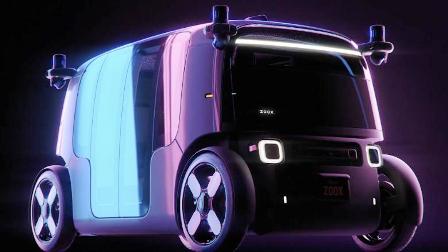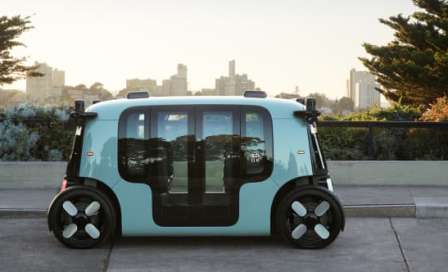Too small. Too unpleasant for passengers. Zoox, bought by Amazon, makes what it calls a robotaxi. But it looks like a robot shuttle and is a bad compromise of both.
As the IDTechEx reports on each explain, a robotaxi is usually an adapted car.
Elon Musk expects you to lend your Tesla X to Uber for the day when its autonomy is acceptable. Uber customers would then travel in the lap of luxury up to seven at a time, or five with huge airline bags. The robot shuttle, as the name implies, is like a weaver’s shuttle, symmetrical so no U-turns.
It is gated in speed and, therefore, allowed over plazas and into malls. And it is multipurpose to get fast payback and reduce congestion in cities and achieve high price when resold. (See IDTechEx reports, “Robot Shuttles and Autonomous Buses 2020-2040” and “Autonomous Cars and Robotaxis 2020-2040: Players, Technologies and Market Forecast.”)
Zoox says it is prioritizing the passengers. But its tiny shuttle has them on bench seats coughing in each others’ faces from a short distance opposite and possibly touching. That is worse than a London or New York taxi, and where do the big bags go?
Zoox is proud of its very small footprint. But it is footprint-per-passenger that matters. And regular shuttles, being larger and having standing room, are similar or better on that metric. Zoox trumpets that it goes twice as fast as a robot shuttle in both directions.
Having that very heavy 133 kWh battery underneath certainly means that it is very unlikely to roll in a freeway accident. But where is the crumple zone at both ends for when it hits a truck, tree, or bridge?
With no shock absorption, will not the seat belts slice through the passenger like butter? That is the Cybertruck problem. Illegal in Europe?
Zoox are proud of the massive redundancy of both powertrain and autonomy. Only one other robotaxi or shuttle company has more lidars(a method for measuring distances, by illuminating the target with laser light and measuring the reflection with a sensor) . And there are plenty of cameras and radars too. This is a wise beginning when safety is paramount, because you must, for a while yet, share the city road with monster vehicles and manic pedestrians.
True, the lidars mean Zoox vehicles cannot just be dropped anywhere as Tesla intends. Maps must be made and constantly refreshed so Zoox is targeted at and limited to defined busy city areas.
Zoox is an engineering-led project, and there are other good sides to this. The outsized battery that lasts all day is wise for what has to be an intensively-used, expensive vehicle. Vectored steering adds more expense. But it gives improved positioning without the full cost of sideways docking. It is wrong to criticize the appearance, as some have. Some like the appearance and anyway, those hailing a ride do not care.
Owner Amazon may wish to carry the necessarily small number of parcels in gutted Zoox vehicles in low-density areas, but that is not mainstream. Amazon is well progressed elsewhere with regular-size city delivery trucks that are its primary last-mile need. Zoox cannot open the gate and climb to your front door with a parcel. So as one commentator has said, “Zoox is basically a one-trick pony”.
Zoox needs to employ a marketing vice president before it is too late. He or she will point out that there is no palette of options with their vehicles. For example, larger windows would give a better passenger experience and attract income from the new transparent-glass micro-LED displays selling advertising.
A larger vehicle would permit wheelchair access and standing room for busy times sought by so many cities.
Zoox must look at the aptly-named Toyota e-Palette robot shuttles that are large enough to move serious numbers of people and earn multiple paybacks from electronically reconfiguring throughout the day.
 They would permit cities to ban little-used, dedicated vehicles such as school buses and private cars clogging up the roads and the parking real estate. Toyota is building a smart city below Mount Fuji based on its smart shuttles that may even abolish sidewalks. Amazon Logistics is a partner in this smart city.
They would permit cities to ban little-used, dedicated vehicles such as school buses and private cars clogging up the roads and the parking real estate. Toyota is building a smart city below Mount Fuji based on its smart shuttles that may even abolish sidewalks. Amazon Logistics is a partner in this smart city.
Amazon should build its own smart city but, in it, the tiny Zoox pods will not reconfigure for fast food, library, utility vehicle, and so on, nor act as better ride-hailing vehicles. Not very useful at all.
Dr Peter Harrop of analysts IDTechEx advises: “We track 37 robot shuttle projects worldwide. They are trialing in 20 countries. Beyond Zoox, only three are with such tiny vehicles. The optimum has been identified for multiple paybacks, reducing congestion, and enabling the disabled and those with limited funds. It is 15-25 passengers, and that is where most robot shuttles sit.
“Smaller vehicles can rarely if ever, get payback on the necessarily high technology cost. Examples of excellence are Local Motors Olli and Navya in the West, and the Baidu shuttles already deploying in China.
In contrast, autonomous taxis for very small numbers of people is a limited market, where passengers will have more-comfortable, lower-cost options than Zoox that can even take them and their big bags to the airport.”
©Copyright MOTORING WORLD INTERNATIONAL.
All rights reserved. Materials, photographs, illustrations and other digital content on this website, may not be reproduced, published, broadcast, rewritten or redistributed in whole or in part without prior written permission from Motoring World International
Contact: editor@motoringworldng.com





